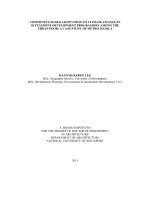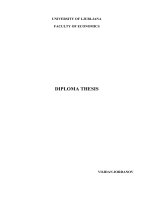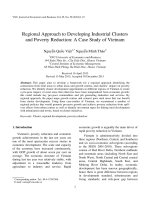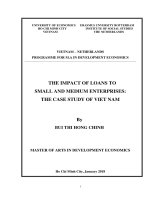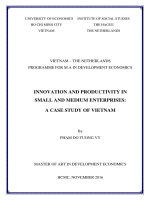How to identify and use cohesive devices in effective english reading comprehension and vocabulary studying a case study of esp fourth year students at ftu m a 60 14 10
Bạn đang xem bản rút gọn của tài liệu. Xem và tải ngay bản đầy đủ của tài liệu tại đây (789.6 KB, 147 trang )
VIETNAM NATIONAL UNIVERSITY – HOCHIMINH CITY
UNIVERSITY OF SOCIAL SCIENCES & HUMANITIES
DEPARTMENT OF ENGLISH LINGUISTICS & LITERATURE
HOW TO IDENTIFY AND USE COHESIVE DEVICES
IN EFFECTIVE ENGLISH READING
COMPREHENSION AND VOCABULARY STUDYING
A CASE STUDY OF ESP FOURTH-YEAR STUDENTS AT FTU
Submitted to the Department of English Linguistics & Literature in partial
fulfillment of the Master’s degree in TESOL
By
TRAN HUONG PHONG
Supervised by
DANG THI HUONG, EdD.
Ho Chi Minh City, November 2011
ACKNOWLEDGEMENTS
I would like to express my deepest gratitude to my supervisor, Dr. Dang Thi Huong,
for her very careful reading of my manuscript, her invaluable comments and
wholehearted support and advice, without which my study could not have been
completed.
I am greatly indebted to all teachers of this TESOL course at HCMC University of
Social Sciences and Humanities for their dedication and helpful instruction during the
course.
My special thanks go to Ms Le Hong Linh, Vice Dean of the Faculty of ESP, Foreign
Trade University, other teachers and students of this Faculty, without whose kind
assistance and cooperation, the thesis could not have been possible.
I am also grateful to my friends and classmates in TESOL 08 for their help and
encouragement.
Finally, I would like to take this opportunity to thank my mother, my son and my
sisters for their love, understanding and constant support to me at any time of
hardship in my life.
i
CERTIFICATE OF ORIGINALITY
I hereby certify my authorship of the thesis submitted today entitled:
HOW TO IDENTIFY AND USE COHESIVE DEVICES IN EFFECTIVE
ENGLISH READING COMPREHENSION AND VOCABULARY STUDYING:
A CASE STUDY OF ESP FOURTH-YEAR STUDENTS AT FOREIGN TRADE
UNIVERSITY.
in terms of the statement of Requirement for Theses in Master’s Programs issued by
the Higher Degree Committee.
Tran Huong Phong
HCMC, November 2011
ii
RETENTION AND USE OF THE THESIS
I hereby state that I, Tran Huong Phong, being the candidate for the degree of Master
of TESOl, accept the requirement of the University relating to the retention and use of
Master’s Theses deposited in the Library.
In terms of these conditions, I agree that the original of my thesis deposited in the
Library should be accessible for the purposes of study and research, in accordance
with the normal conditions established by the Library for care, loan or reproduction of
theses.
Ho Chi Minh City, November 2011
iii
TABLE OF CONTENTS
Page
Acknowledgements .........................................................................................................i
Certificate of originality .................................................................................................ii
Retention and use of the thesis ......................................................................................iii
Table of contents ...........................................................................................................iv
List of abbreviations .......................................................................................................v
List of tables ..................................................................................................................vi
List of figures ...............................................................................................................vii
Abstract .......................................................................................................................viii
CHAPTER 1:
INTRODUCTION
1
1.1
Background to the study...................................................................................1
1.1.1
The importance of EFL reading and vocabulary studying ...............................1
1.1.2
Cohesion and coherence in relation to English reading comprehension
and vocabulary learning ...................................................................................2
1.2
ESP programme at Foreign Trade University ..................................................3
1.2.1
Descriptions of ESP courses at FTU ................................................................3
1.2.2
ESP students’ problems in reading comprehension and vocabulary
learning .............................................................................................................8
1.3
The aims of the study .....................................................................................10
1.4
Significance of the study ................................................................................11
1.5
The organization of the study .........................................................................12
CHAPTER 2:
2.1
LITERATURE REVIEW
13
The concept of cohesion.................................................................................13
iv
2.2
Cohesion, coherence and textuality................................................................15
2.3
Different types of cohesive devices................................................................18
2.3.1
Grammatical cohesion ....................................................................................20
2.3.2
Lexical cohesion ............................................................................................24
2.4
Cohesive devices and the organization of texts..............................................27
2.4.1
Text and discourse ..........................................................................................28
2.4.2
How text is composed?...................................................................................29
2.4.3
Discourse structure signaling system in texts.................................................31
2.5
Cohesion and the reading process ..................................................................33
2.5.1
Reading as a communicative event ................................................................33
2.5.2
Problems in reading comprehension ..............................................................34
2.5.3
Text analysis and interpretation in reading comprehension ..........................35
2.5.4
The role of cohesion in analysing texts ..........................................................36
2.5.5
Developing reading skills and strategies ........................................................39
2.5.6
L2 reading curriculum for reading development............................................41
2.6
Cohesion in the reading-vocabulary relationship...........................................43
2.6.1
Vocabulary demand for effective reading comprehension ............................43
2.6.2
The place of lexical cohesion in vocabulary learning ....................................44
2.7
Cloze tests.......................................................................................................45
CHAPTER 3:
METHODOLOGY
48
3.1
Research questions .........................................................................................48
3.2
Research design ..............................................................................................48
3.2.1
Characteristics of the subjects ........................................................................49
3.2.2
Instruments .....................................................................................................53
3.3
Data collection procedure...............................................................................59
v
CHAPTER 4:
DATA ANALYSIS AND FINDINGS
61
4.1
Data analysis...................................................................................................61
4.1.1
Problems in English reading and vocabulary studying ..................................61
4.1.2
Types of cohesive devices were frequently recognised by students ..............80
4.1.3
The helpful dimension of cohesive devices in the studying of
reading comprehension and vocabulary.........................................................86
4.2
Findings ..........................................................................................................91
CHAPTER 5:
CONCLUSIONS AND RECOMMENDATIONS
97
5.1
Conclusions ....................................................................................................97
5.2
Recommendations ........................................................................................100
REFERENCES
108
APPENDICES
115
Appendix 1:
Cloze test A, and test B and Answer keys
Appendix 2:
Reading exercise 1, exercise 2 and Answer keys
Appendix 3:
Criteria for identifying and selecting deleted items in test A
and test B
Appendix 4:
Classification of deleted items in test A and test B according to
the criteria described in Appendix 3
Appendix 5:
Number of students correctly answering on different items
Appendix 6:
Questionnaires for students and teachers
vi
LIST OF ABBREVIATIONS
ESP
English for Specific Purposes
EFL
English as a foreign language
ELT
English language teaching
FL
Foreign language
L1
First language
L2
Second language
ESL
English as a second language
FTU
Foreign Trade University
USSH
University of Social Sciences & Humanities
TOEIC
Test of English for international communication
TESOL
Teaching English to speakers of other languages
NEM
Non-English major
vii
LIST OF TABLES
Page
Table 3.1
Students’ personal information
50
Table 3.2
Characteristics of ESP teachers
52
Table 4.1
Students’ ideas about the language knowledge needed for
improving reading comprehension
63
Table 4.2
Students’ opinions about skills employed in studying reading
comprehension
64
Table 4.3
Students’ opinions about factors causing problems in
studying English reading comprehension
65
Table 4.4
Students’ ideas about vocabulary studying
66
Table 4.5
Students’ focus on different vocabulary knowledge
67
Table 4.6
Vocabulary learning strategies used by students to explore
new words
69
Table 4.7
Students’ ideas about methods to infer word meanings from
the contexts
70
Table 4.8
Teachers’ ideas about the language knowledge needed for
improving reading comprehension
71
Table 4.9
Teachers’ focus on the components of a reading curriculum
for reading comprehension development
72
Table 4.10
Teachers’ opinions about skills employed in studying reading
comprehension
74
Table 4.11
Cohesive devices employed to explore meaning relations
75
Table 4.12
Teachers’ ideas about factors causing problems in studying
English reading comprehension
76
Table 4.13
Teachers’ focus on various vocabulary knowledge
78
viii
Table 4.14
Teachers’ opinions about methods of inferring word
meanings from the contexts
79
Table 4.15
Students’ performances on Exercise 1
84
Table 4.16
Comparison of different types of deletions in test A and test
B
87
Table 4.17a
Descriptive statistics of students’ scores on test A and test B
Table 4.17b
Frequencies of students’ scores on test A and test B
88
Table 4.17c
Students’ scores on test A and test B
89
Table 4.18
Students’ scores on the reading exercises
91
ix
88
LIST OF FIGURES
Figure 3.1
Student’s level of English proficiency
51
Figure 4.1
Priority given to the four language skills by ESP students at
FTU
62
Figure 5.1
Decision chart for dealing with low-frequency words in
specialized texts.
104
x
ABSTRACT
This case study is an attempt to investigate how English cohesive devices can help
ESP students learn reading comprehension and vocabulary more effectively. Cohesive
devices are identified in accordance with the classification proposed by Halliday and
Hasan (1976), and modified by Nuttall (1982). Research was made within descriptive
framework, and methods of analysis applied in the study were both qualitative and
quantittive, due to the nature of data collected. The data comprised structured survey
questionnaires for ESP teachers and fourth year students at FTU, and two cloze tests
and reading exercises.
The findings of the study indicated that lack of knowledge about cohesion, coherence
and the use of cohesive devices in organizing a text might cause problems for learners
in studying reading comprehension and vocabulary. The need to develop a large
vocabulary is urgently required, since an inadequate vocabulary knowledge has been
considered as a potential difficulty for students in foreign language learning.
Therefore, vocabulary studying should be one of the main components of a reading
course. It also suggested that if students were explicitly, systematically and carefully
taught these cohesive devices, their notions and terminology, they would find it much
easier to recognize, and use them more effectively in their learning of English reading
comprehension and vocabulary.
The study came up with some suggestions that make use of cohesive devices for
effectively improving reading comprehension ability and vocabulary knowledge for
ESP teachers and learners at FTU. It is hoped that this study would be able to give
light to the application of a reading course especially suited for ESP programme.
xi
CHAPTER 1
INTRODUCTION
The thesis is designed to carry out a study of how fourth-year ESP students at Foreign
Trade University (FTU) can take advantage of cohesive devices as a specific
discourse feature to assist them in studying reading of English texts and enlarging
their vocabulary knowledge effectively.
1.1
BACKGROUND TO THE STUDY
1.1.1
The importance of EFL reading and vocabulary studying
This part presents the importance of reading skills and vocabulary knowledge in
foreign language teaching and learning, and the role of cohesion and coherence as
essential discourse features in the studying of English reading comprehension and
vocabulary. It also discusses about the major significance of reading comprehension,
particularly for ESP students at FTU, as well as some most common problems that
teachers and learners often encounter in their teaching and learning of English for
specific purposes.
The reading of the first language is crucial for most of us as an effective way to learn,
to obtain information, to broaden our knowledge, and to entertain. The reading of a
foreign language in academic contexts is of even greater significance that has been
recognised and affirmed by several famous researchers (Grabe, 1991, 2009; CelceMurcia & Olshtain, 2000; Carrell & Grabe, 2002). Reading is not only one of the four
basic language skills required by any course of EFL teaching and learning, but also
the greatest available means by which learners are exposed to English language
Page 1
environment through printed materials. Closely related to reading ability is
vocabulary knowledge. Just like grammar, vocabulary is the core of linguistic
competence, as Read (2000, p. 1) comments: “words are the basic building block of
language, the units of meaning from which larger structures such as sentences,
paragraphs and whole texts are formed”. The knowledge of vocabulary involving
knowing the meanings and many other aspects of words, thus is fundamental to
communicative competence, and apparently to the interpretation and comprehension
of texts.
Because of its significance, the continuous acquisition and improvement of
vocabulary knowledge is vital to any FL learner in order to master the language, and
to become a skilled reader. Since it is impossible for students to learn every new word
they read, they should be taught how to cope with unfamiliar words, how to develop
and effectively use reading and vocabulary learning strategies for a better
comprehension. More importantly, reading and vocabulary learning do not only take
place in class but also outside the classroom whenever possible, even after graduation.
Good strategies for studying English reading comprehension and vocabulary then
would represent the way which students could make use of to become autonomous,
life-long learners in the long run.
1.1.2
Cohesion and coherence in relation to English reading comprehension
and vocabulary learning
Together with the rapid development of discourse analysis, cohesion and coherence,
often viewed as specific features of texts, have received particular attention and
become the focus of investigation for many researchers. Halliday and Hasan (1976,
p.26) demonstrate that cohesion and coherence are two essential qualities of texts that
“distinguishes text from non-text”. According to these authors, the function of
cohesion is to semantically connect one part of the text to another parts which have
Page 2
gone either before or after that part, thus lending “continuity” to the text (p. 299).
These connections are referred to as cohesive chains, based on which the reader
would be able to reconstruct all components of the text in its entirety for
comprehension (Halliday & Hasan, 1976, p. 331). Therefore, it is reasonably assumed
that the knowledge about meaning relations between lexical items in a text could
provide students with a useful tool for decoding that text, and help enlarge the
knowledge of vocabulary as well.
Recognizing the role of cohesion in forming a text largely through the use of
grammatical and lexical devices, Celce-Murcia & Olshtain (2000, p. 126) state that
cohesion which “relies heavily on grammatical and lexical devices” requires a
reader’s language ability, so unless readers have enough knowledge of cohesive
devices and their function in text organization, they might miss important clues from
the text, and as a result, have difficulties in the reading process. Nunan (1999) also
suggests that it is significant to have some understanding of “text forming devices”
and the way they serve to create texture, and that explicit instructions of how to use
these devices in reading and writing can be beneficial to English learners (p. 126).
1.2
ESP PROGRAMME AT FOREIGN TRADE UNIVERSITY
1. 2.1
Descriptions of ESP courses at FTU
The teaching of English for Specific Purposes (ESP) plays a very important role in
higher education, due to both a great number of Non-English majors at tertiary level
nowadays, and the great demand of the society, especially in the new context of
international integration and globalism. Its aim and objectives are to meet the specific
needs of learners, to provide them with adequate knowledge of English required by
their specialized job in the near future (Dang, 2004; Do & Cai, 2010). In one of her
study of ELT at tertiary level and the role of English as a world language and
Page 3
especially in Viet Nam, Dang says that “…even ESP requires a wide range of
activities in FL, in which the four language skills ought to be developed” (Dang,
2004, p. 91).
FTU is where students are trained to become international business people, and this
university has a long established good reputation for teaching foreign languages,
particularly foreign languages for specific purposes. Apart from its primary focus on
such main education programmes as international economics, business administration,
international business, finance and banking, technology and some other related fields,
FTU also specializes in business foreign languages including English, French,
Russian, Japanese, and Chinese. Each language is conducted by one faculty, with the
exception of English which is taught in two faculties to meet the learners’ requirement
for this language. There are the Faculty of Business English, and the Faculty of
English for Specific Purposes which aims at teaching English language needed for the
particular professions educated at FTU.
In the Faculty of ESP, the purpose of English teaching and learning is not only to
teach the language itself but also necessarily to achieve non-linguistic aims. Students
are educated and trained to work with foreign partners and customers in many
contexts such as doing business, taking part in meetings, conducting negotiations,
handling claims or even telephoning and using English in social contacts. The most
important goal is to develop communication skills in English that students need to
succeed in their future career, among those skills, reading and writing (together with
translation) are of paramount significance. In order to achieve the goals of FTU,
improving reading skills and enlarging business vocabulary size become an essential
requirement for any ESP course in this University.
For students majored in the specializations other than foreign languages, English is a
main subject taught throughout the whole programme at the university. Students have
Page 4
to learn English for 630 periods (one period is equivalent to 45 minutes class-contact),
divided into two phases: the initial phase involves teaching basic English during the
first four semesters; the second phase focuses on teaching specialized English
together with advancing students’ knowledge of general English during the next three
semesters. Therefore, in the first as well as the second phase, the Market Leader, New
Edition (D. Cotton, D. Falvey, & S. Kent. Pearson, Longman) is used as the textbook
and practice files. These books are specifically designed for multi-level business
English courses to provide students of business with basic knowledge of English
structures and necessary vocabulary. The books also aim at developing the learners’
ability to communicate in English, that help them pass the standard TOEIC tests
required on the completion of the first phase with the result of at least 400 scores, and
of the second phase with at least 620 scores.
In the second phase, besides the Market Leader, teaching materials in use consist of
the following:
1)
A Handbook of Commercial Correspondence (by A. Asley, 1995, Oxford);
2)
Giáo trình Thư tín Thương mại (by Dr. Nguyen Trong Dan); and
3)
ESP I, ESP II compiled by ESP teachers to meet learners’ specific needs.
Commercial correspondence is a main subject taught in separate courses to provide
students with knowledge and skills to deal with various kinds of business letters in a
wide range of business scopes and situations. At the same time, the purpose of ESP I
and ESP II courses, as stated in Course Introduction, is to familiarize students with
the basic concepts of different areas of business. These two courses incorporate
instructions and various classroom activities including reading, discussion, minipresentation and other practices. Total teaching time for each of these ESP courses is
within 45 periods which lasts for five weeks, i.e. 9 periods per week, including a midterm test and a final exam. As far as continuous assessment is concerned, students’
Page 5
performance is evaluated on the basis of their class attendance and active contribution
(10%), the result of mid-term test (20%) and the final exam (70%).
Course syllabuses for ESP I and ESP II with a focus on FTU specialized subjects are
as follows:
TOPICS
Number
of class
ESP I
ESP II
Class 1
Company structure
International trade
Class 2
Management and cultural diversity
Banking
Class 3
Human resources
Finacing foreign trade
Class 4
Work motivation
Accounting
statements
Class 5
Marketing
Stock and bond
Class 6
Pricing
Mid-term test (60 minutes)
Class 7
Advertising
Futures and derivatives
Class 8
Mid-term test (60 minutes)
Merger and acquisition
Class 9
Arbitration
Central banking
Class 10
Torts
Exchange rates
Final exam
Final exam
and
financial
From the teaching materials used in the Faculty of ESP at FTU, we can get some
general ideas about the main course structure and teaching methods applied to the
ESP training programme. In ESP I and ESP II, the lesson plan for class activities
could be summarized as follows:
Page 6
1.
Pre-reading activities
Answering questions; some small discussion may be employed before
reading.
2.
Vocabulary: selecting key words to focus on.
Reading
Reading the text, and answering the questions.
Doing reading comprehension tasks with a variety of exercises, such as
finding equivalence between words/expressions in the text with given
words/expression; finding synonyms, or logical connections among
words/group of words in the text; true/false.
Practising summarizing skill with a variety of exercise types
Discussion: involving a variety of exercises done by pair work or group
work
-
Completing sentences;
-
Putting words in their correct places;
-
Matching up nouns/verbs to make common collocations;
-
Matching words with their definitions/examples/explanations;
-
True/false;
-
Doing cloze exercises,
-
Doing exercises concentrating on grammar,
-
Assigning writing tasks.
So, in both phases of the ESP programme at FTU, the use of the Market Leader aims
at providing students with general knowledge of English, developing all four language
skills but also with a focus on business topics. In the second phase, ESP I and ESP II
Page 7
are employed with an emphasis on training reading comprehension and writing skills
with various kinds of activities and exercises for the special purpose of FTU.
1.2.2
ESP students’ problems in English reading comprehension and
vocabulary learning
It is obvious that the role of reading comprehension and vocabulary knowledge for
ESP students at FTU is of great importance. After graduation, FTU students are
supposed to be competent to communicate in English, particularly to deal with
English texts of all kinds, such as sale contracts, insurance policies, charter party, bills
of lading or letter of credit, and so on. However in reality, it is not always true due to
several reasons, both objective and subjective. As a result of the Grammar-Translation
method which still has a long lasting effect on the way of FL teaching and learning in
Vietnam, generally speaking “students read and understand the text very slowly, and
they are always passive in the reading clasroom” (Nguyen, 2000, p. 2). As
commented by Do & Cai (2010) on the quality of and challenges to the teaching of
ESP presently, in many cases, although achieving quite high marks at university,
students could not use English for their work. Their English proficiencies are far from
satisfying the requirement and they need to be retrained in foreign languages.
Le (2006), an ESP teacher at FTU who studied lexical devices in the textbook
“International Business” previously taught at FTU, also said about students’ problems
in her research that it was easier for students to notice grammatical cohesive devices,
but they neither took lexical cohesive devices into sufficient consideration, nor knew
how to use them properly when reading or writing. The weakness in the analysis and
interpretation of English texts might partly result from learners’ poor knowledge of
vocabulary, and from their inadequate awareness of all kinds of English cohesive
devices and of their role in creating texture. So “an awareness and understanding of
Page 8
cohesive devices may turn out to be vital for students of English in improving their
reading comprehension and translation” (Le, 2006, p. 2).
As a student of FTU, and long after that a EFL learner at the Department of English
Linguistics and Literature, USSH, National University of HCMC, I shared Le’s view
that in general, the majority of students lack a good knowledge of English vocabulary,
particularly the knowledge of English cohesive devices and discourse organization,
thus affecting their ability to comprehend a text or to compose a coherent piece of
writing. It also came from my own working experience in this field that most texts in
textbooks are simplified, but this is not the case with authentic texts in business areas,
the complexity of which might give rise to problems for the readers, unless they have
inadequate knowledge of these cohesive devices and discourse organization to analyse
the text, and to overcome their language deficiencies.
So it was believed that if students were made well aware of such specific language
devices right at university, they would be able to cope with various kinds of texts on
their own for a better understanding in their future job. Apart from reading
competence, it is also necessary for ESP learners to build up a large vocabulary in
relation to international economics and foreign trade areas. Furthermore they need to
learn how to bridge this lexical gap to read more effectively, especially through
making use of these cohesive devices. Hence, there is a real need for making ESP
students at FTU more conscious of these cohesive devices in the organisation of texts,
thus enhancing their reading comprehension and vocabulary learning.
I have started a course of teaching English reading and writing for my young
colleagues in our company as a part of the training programme for some months. I am
greatly interested in it, so I intend to spend more time on teaching after finishing this
TESOL course. This experience also gives me a good reason for trying my best to
Page 9
complete the study in the hope that it would be useful for my teaching in the very near
future.
1.3
THE AIMS OF THE STUDY
The views about the effect of cohesive devices on reading comprehension are
differing among researchers. It may result from the fact that there are still few
empirical studies of this language area. Therefore, it is necessary to find out evidence
for an approach to teaching English cohesion to promote reading comprehension and
vocabulary learning, especially at tertiary level. On the basis of previous researchers’
achievements in the field, and with the motivation for exploring how to make use of
cohesive devices from discourse-based approach to develop reading and vocabulary
learning of ESP students at FTU, this study aims at:
Finding out whether FTU students are able to identify and use specific cohesive
devices to promote the study of English reading comprehension and vocabulary;
Looking for some effective ways to help the learners promote their learning of
English reading comprehension and vocabulary through using these specific
language elements.
In order to achieve the aims of the study, the research process is guided by three
research questions as follows:
1)
What are the most common problems ESP students at FTU have in reading
comprehension and vocabulary learning, particularly the problems in relation to
cohesive devices?
2)
What kinds of cohesive devices are frequently recognised by the students while
reading an English text?
Page 10
3)
To what extent can these cohesive devices help students with their effective
studying of English reading comprehension and vocabulary?
1.4
SIGNIFICANCE OF THE STUDY
The study aimed at examining English cohesive devices and their effect on the
studying of reading comprehension and vocabulary from both theoretical and practical
aspects. Therefore, it is considered important to ESP students at FTU. The findings of
the study may suggest the following contributions:
-
The study provides empirical evidence to support the idea that the teaching of
cohesive devices might help learners develop the studying of English reading
comprehension and vocabulary knowledge in the process of active interaction
between the students and the text. At least, it could make students aware of all
kinds of cohesive devices and their functions in organizing a text, thus gives rise
to a better analysis and understanding of the text.
-
The study also has some implications for reading pedagogy and further research
on reading. It is suggested that different kinds of reading activities and strategies
be further explored to develop students’ reading comprehension ability. A
number of exercises in relation to English cohesion could be fully employed to
draw students’ attention to specific features of a text, to train them in dealing
efficiently with new vocabulary and complicated texts to improve their English
reading competence and vocabulary knowledge.
-
This research also has some practical value in training students for being capable
of studying on their own, i.e. independent learning of English reading
comprehension and vocabulary which is badly needed for their coming job. It is
hoped that being well provided with skills and strategies to deal with unfamiliar
Page 11
words and challenging texts, students would be able to cope with authentic texts
in terms of length, complexity, a variety of text types and contents, and
especially to acquire a large vocabulary size spared for their future work.
1.5
THE ORGANIZATION OF THE STUDY
The research includes five chapters. Chapter One is an introduction presenting the
background to the study, rationale for the study, research questions, the aims of the
study as well as its significance, and the organization of the study.
Chapter Two provides a review of relevant literature which deals with the concept of
cohesion and coherence, different types of cohesion and how cohesive devices can
contribute to the organization of a text. This chapter also presents the need for reading
comprehension, the relationship between reading ability and vocabulary acquisition,
the use of cohesive devices including discourse markers, text-structuring patterns as
particular kinds of cohesion above sentence level, and their significance in the
interpretation and comprehension of texts.
Chapter Three focuses on the methodology employed in the study which consists of
research questions, research design, the characteristics of the subjects, and methods of
collecting data. This chapter forms the basis for data analysis and discussion of the
findings in the next chapter, Chapter Four.
Chapter Five provides a conclusion of the study and suggests implications for the
teaching and studying of reading comprehension, and enlarging vocabulary by way of
making students aware of cohesive devices and its use in text organization.
This chapter has just presented the Introduction, next chapter – chapter Two
introduces the theoretical framework for the study.
Page 12
CHAPTER 2
LITERATURE REVIEW
This chapter presents an overview of the relevant literature concerning the concept of
cohesion; cohesion, coherence and textuality; different types of cohesive devices;
cohesive devices and the organization of texts; cohesion and the reading process; and
the place of cohesion in studying reading comprehension and vocabulary.
2.1
THE CONCEPT OF COHESION
The research on English cohesion conducted by Halliday and Hasan (1976) is
considered the most influential theory of English cohesion as commented by Brown
& Yule (1983) “it is by far the most comprehensive treatment of the subject and has
become the standard text in this area” (p. 190). Cohesion theory investigates specific
kinds of meaning relations that are important to link elements of a text at the above
sentence level to create texture. Halliday and Hasan’s model of English cohesion
hence serves as theoretical framework for the analysis of cohesion as text-forming
devices in this study. Besides, the views of other authors like Nuttall (1982), CelceMurcia and Olshtain (2000), McCarthy (1991), and Grabe (1991, 2009) on cohesion
and the aspects relating to reading comprehension and vocabulary pedagogy are also
taken into consideration to provide the conceptual basis for the study.
Different authors have different ways to describe the notion of cohesion. Halliday and
Hasan (1976, pp. 4-12) say that “cohesion is a relational concept”, it refers to a set of
meaning relations between one item and some other elements in a text that provides
the text with “texture”. According to Halliday& Hasan (1976), a text is said to be
cohesive “where the interpretation of any item in the discourse requires making
Page 13

